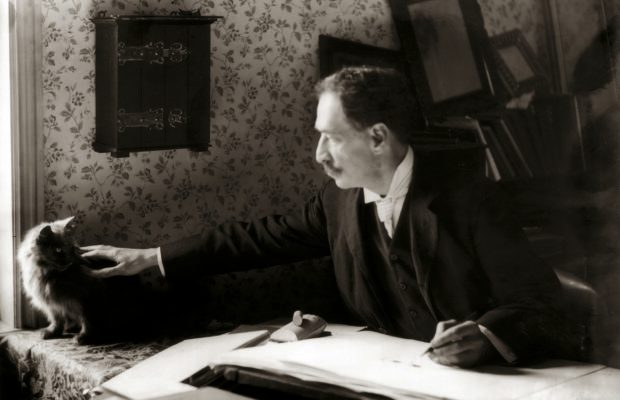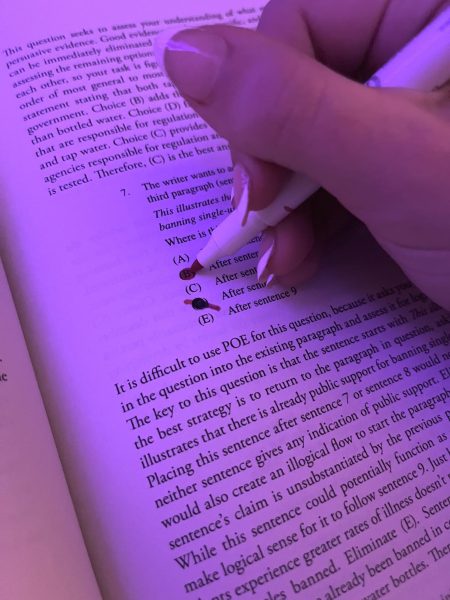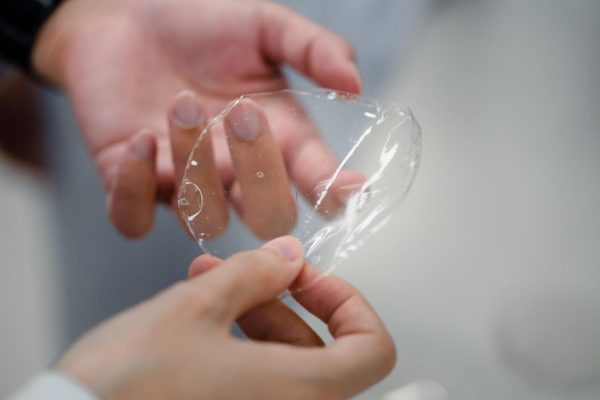Louis Wain – And How He Changed The World
October 17, 2022
Although known for his paintings, eccentric artist Louis Wain single-handedly changed the way cats are viewed in society.
Louis Wain was an artist from the 1860’s till the 1930’s. He grew up in Clerkenwell, London with his 5 sisters. He was the oldest child, and only male, so when his father died in 1880, 20 year old Louis was forced to assume the role of man of the Wain household. His family soon discovered that Louis was far from fit to be the sole provider. Louis was often impulsive, and was a bit careless with money. He preferred working with his passions, and would refuse any kind of real work because it just didn’t peak his interests. He was commonly known as quite the “oddball” and would act very irregular to societal norms of the time.
Despite being erratic at times, and often peculiar in character, he was always a fantastic artist. He started his artistic career with freelance dog portraits and occasional newspaper illustrations. When his family was beginning to worry about poverty, he reluctantly signed on to be a full-time illustrator for the Illustrated London News. With the steady paychecks the family received for his work, the Wains could afford to hire a Governess for the younger of the 6 siblings. This is how Louis met his wife, Emily Richardson, the sole inspiration of Louis Wain’s cat portraits. Unfortunately, the two would only be married for 3 years before Emily would die of breast cancer at age 36.
The newly married couple stumbled upon a black and white kitten one day, whom they named Peter and took in as a pet. This was quite the rebellious act, since at the time cats were only seen as good for hunting mice. The three were a far from ordinary family, and Louis decided he wanted to capture that with his artwork. He started drawing Peter in ways that showed how ridiculous cats really were, in attempts to lift Emily’s spirits while she was sick. These works of art cheered Emily up so much that in fact, she pushed for Louis to publish some to a public newspaper for everyone to see. His first publication of his feline artwork was “A Kitten’s Christmas Party,” a spread of several drawings of cats participating in festive activities for the Illustrated London News Christmas Edition. It was immediately a hit, and from there on he was in high demand for these silly little cat drawings. His career started to take off, and only three days later his beloved wife passed away.
This was a turning point for Louis, but sadly not in the best of ways. He buried his grief in his work, and produced high quality paintings, drawings, and a variety of prints through it all. Peter kept him company, and his family eventually had to move back in with him when they became too poor to pay for their own house. You would think that with his artwork getting so much attention, the Wain family would be living comfortably for the rest of their lives. However, they weren’t so lucky, as Louis forgot to copyright all of the artwork he sold. While his paintings were being reprinted and sold around the world, he didn’t get to see a single penny of it his entire life. Despite being painfully poor, he was a part of numerous cat organizations and charities and helped normalize cats being household pets throughout the U.K. and eventually America.
Through all his good works and seemingly upbeat attitude, Louis’ mental stability only continued to deteriorate as time went on. Everyone who was acquainted with Louis knew him as eccentric, but what many didn’t know is that he had struggles with mental health throughout his life. The loss of his wife caused him an insane amount of heartache; however, when their Peter passed away at age 15, Louis cried for years on end. His heart was utterly shattered, and he decided to go to America for a few years in an attempt to flee his grief. He worked on several different newspapers in New York, creating comic strips in his classic feline style; however, his illustrations grew unpopular due to his comments on American laziness within the art. He soon moved back home, due to his mother dying of influenza.
From there, things only got worse for the Wain family. Their youngest sister, Marie Wain, had been committed to a psych ward for showing symptoms of schizophrenia, and she died of the influenza virus while in treatment. His other sister, Caroline, also died of influenza soon after. This was Louis’ breaking point; after his two sisters died he started accusing the other three of murdering them and would come up with wild delusions about their involvement in their death, as well as hyperfocus on theories about electricity being the driving force of the universe. He was soon committed to several hospitals for treatment of his erratic behavior, and was considered clinically insane in 1924. He is known as the painter who developed schizophrenia, which is shown in his “psychedelic” like depictions of cats; however, modern day psychologists believe that he may have gotten an incorrect diagnosis. He happened to sustain a major brain injury a few years before being committed, which doctors at the time didn’t know could cause psychosis-like symptoms if not treated correctly. This may better explain his increasingly violent and outlandish behavior that developed after the incident. It is being speculated that Louis may have been on the Autism Spectrum, which would shed some light on his “unusual” habits throughout the rest of his life. Louis spent the last 15 years of his life in mental institutions, one of which allowed their patients to keep cats for comfort. Throughout his time in treatment, he still continued to create art for his sisters to sell, as they never married and were still completely reliant on his work. Not much of his work has dates on it, since he never copyrighted any of his images. Through all his hard work, his suffering, and his fame, him and his family never got to see the rewards of any of it. As one of the most beloved artists of our time, and founding father of house cats everywhere, he never truly got the recognition he deserved.
It is amazing that even in times when creativity and mental issues were frowned upon, some could speak out loud and properly express themselves, not in a way to combat or argue but to express interest in something they love and make it reality; it truly is inspiring, — Cesar Diaz (12)
“It is amazing that even in times when creativity and mental issues were frowned upon, some could speak out loud and properly express themselves, not in a way to combat or argue but to express interest in something they love and make it reality; it truly is inspiring,” Cesar Diaz (12) had said on the subject of Louis Wain’s effect on the world. This artist was not unlike many artists throughout history; several famous artists struggled with mental health in one way or another. What stands out about Louis is that he started a new era of how billions of people viewed cats as a whole. They had always been viewed as serious, mean creatures that didn’t get along with humans. Louis was able to show the side of cats that many don’t open themselves up enough to see; he showed us that cats are ridiculous, and they can be just as silly as anyone else. They have feelings, interests, and lots of opinions. Louis was able to capture emotions in cats that many had never seen before and made cats an increasingly beloved member of families as the years went on. Modern day house cats would not look the same without the lovely artwork of Mr. Louis Wain.












































Nina Connolly • Jan 29, 2024 at 9:48 AM
What a sad life Mr. Wain had. It was in this sadness that his electricity intensified and his art took on almost a life of its own. I believe when Peter the cat died that his grief from the loss of his beloved wife also intensified as Peter was the only connection Louis had with her.